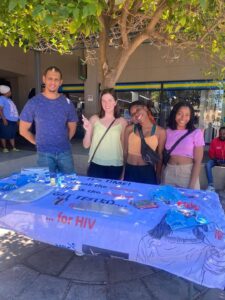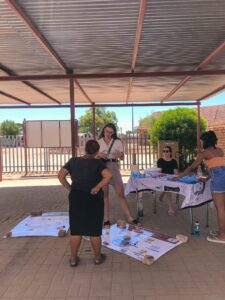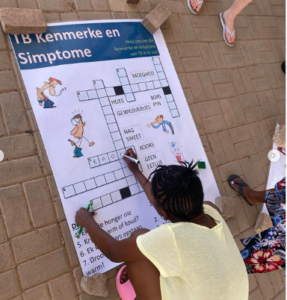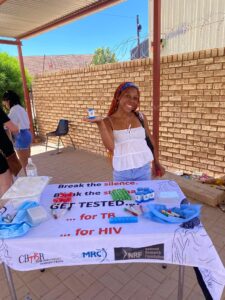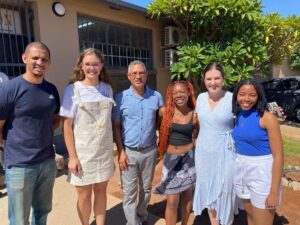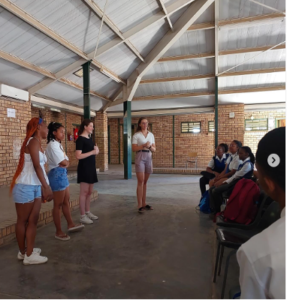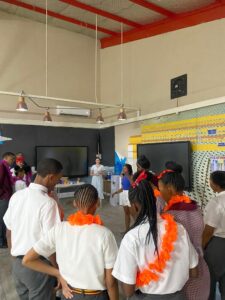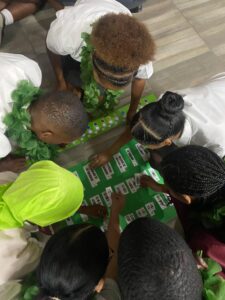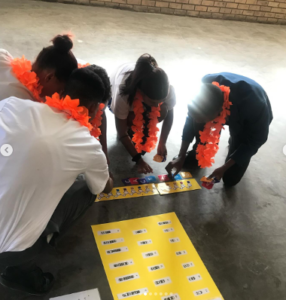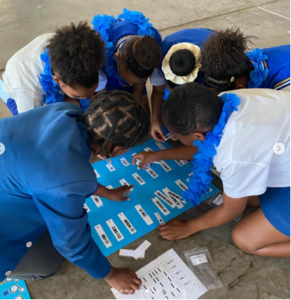Written by Alyce Kapisa
What does 40-degree weather, the world’s smallest international airport and slow drivers have in common? They can all be found in South Africa’s ‘Groen Kalahari’ also known as Upington, in our beautiful Northern Cape province. Other than all that, Upington also happens to boast some potential future scientists in their high schools and clinics that help make our research a reality. And this was exactly why the South African Medical Research Council (SAMRC) Centre for Tuberculosis Research (CTR) and DIPLOMICS helped to sponsor and put all their trust in 5 individuals from the TB Host Genetics research group housed within the Division of Molecular Biology and Human Genetics at Stellenbosch University’s BMRI (Biomedical Research Institute); to go into Upington with one objective: uplift ment.
Upington happens to be a source of many clinical samples for many projects that the TB Host Genetics group is involved in. In light of this valuable contribution to our research endeavors, our main aim was to physically visit these sites to not only thank the phenomenal staff who help us collect and transport these samples, but to also experience, observe and interact with the community that they serve.
As the kids say, it hits different when you actually see the sites where your samples come from, how far they travel to get to our state-of-the-art facility and engaging face-to-face with the study participants is incredibly important too. From deep in the middle of the desert to the BMRI, it was critical for us as research staff and students to go back to those same people and teach them about the exact disease we collected their samples for, tuberculosis (TB). We stopped by the Sarah Strauss clinic, set up a table filled with fake blood collection tubes, Gene Xpert Kits, lollipops, and crosswords with information containing the basic signs and symptoms of TB. We were able to get the word out (in English and Afrikaans which was not an easy feat) and made a few more people aware of what to look out for as well as how easy it is to get tested and the necessary treatment to be cured.
This was not the only highlight of the trip. We also had the opportunity to visit two high schools in the area, Carl van Heerden High School and Saul Damon Secondary School, and interact with matriculants (actual people born in 2006 – shocking). I think we all agreed that this was the most enriching part of the trip. These school visits included teaching the learners about basic genetics using the “Code of Life” game show focused on population genetics and bioinformatics originally developed for the Generation Science (GenS) programme, an annual outreach hosted in collaboration with the SAMRC in celebration of Youth Day.
It was inspiring to see the students and teachers so eager to engage with us and each other and show what they know, learn new things, and teach us a few things too. Our favorite part ever? The teachers! Life science teachers are and will always remain elite. The passion they have for teaching their students and the vast amount of knowledge they carry was so nice to experience and learn from. The learners are definitely in good hands.
We also managed to answer a few questions regarding how diverse the science journey can be: how many opportunities there are in university and the many avenues that are out there waiting for them. We also emphasized the importance of trying and not seeing something as unattainable just because of your circumstances. While the Northern Cape may be over 700 kilometers away from the Western Cape, we told them that no dream is too big, and no place too far for them to achieve these dreams. Our goal really was to show them how cool and interesting science was (since most of them were biology students they already had somewhat of an idea) and encourage them to keep working hard and grab as many opportunities as possible.
While we barely had any icy water because the sun could not wait to heat it up, we were refreshed by the interactions we had with the different people we interacted with in Upington that it did not matter at all! We would like to thank the clinical team and patients at Sarah Strauss for allowing us continuous access to samples that allow our research to continue. We would like to thank Carlton van Heerden High School and Saul Damon Secondary School for allowing us to come into their space and allowing us to pass on our knowledge to the learners. We would like to thank the residents of Upington for allowing us to raise awareness about TB and asking all the necessary questions. And lastly, we would like to thank DIPLOMICS and the SAMRC CTR for allowing us to carry out such an important task of uplifting a community that is such a necessary part of our daily work. And to everyone in the TB Host Genetics group (specifically Annecke, Nomfundo, Dayna and Devon), kudos to you for planning such a beautiful, interactive, and enriching programme. If you have ever wondered, Upington is worth the visit; just remember to pack your sunscreen and freeze your water the night before!
About the Author
I am Alyce Kapisa, a current masters student in the Immunology Research group at the Division of Immunology. I am a member of the Societal Impact Task Team (SITT)/Social Media Working Group (SciComm) as well as an MMed representative of the Tygerberg Postgraduate Students Council (TPSC). You can usually find me at my desk on the second floor of the BMRI editing social media posts for our department or in the lab investigating the role of red blood cells in the innate immune response to Mycobacterium tuberculosis. I have a passion for both science and people and enjoy opportunities that allow me to combine which is why I love being on SciComm!


